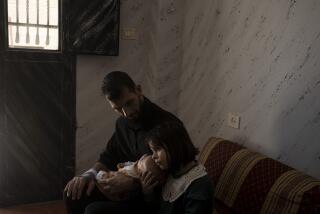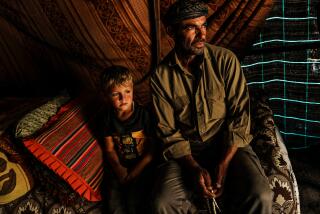Hundreds of Taliban Fighters Set Free
KABUL, Afghanistan â Dirty, disheveled and contrite, the thin men sat on their haunches on the pavement with vacant looks, waiting for a handout. But these were not ordinary beggars. They were former Taliban fighters, released from Sheberghan prison in the north of the country and slowly making their way home.
A few short months ago, they were part of a swaggering religious army that breathed defiance of America and pledged a duel to the death with the worldâs only superpower. Today, all the wind has gone out of them.
Perhaps that explains why, without fanfare, Afghanistanâs new government has started freeing batches of 100 or 200 of its Afghan Taliban prisoners, who were captured or surrendered late last year in the closing days of the U.S.-led military campaign to rid the country of the extremist Islamic regime.
Looking tired and somewhat dazed, bedraggled men like these have been limping back home to their villages in the south of the country around the Taliban strongholds of Kandahar and Helmand since February. They bear an air of ignominy. To anyone who asks, they insist that they never wanted to fight, did not fire their guns and of course would never march off to fight in the future.
âI only plan to sit in my house, to serve my family and to remain resting there for the rest of my life,â said Mohammed Aref, 18, a freed prisoner barely able to sprout a beard and sporting a mop of spiky black hair that looked as if it had been cut in prison with a meat cleaver.
An estimated 5,800 prisoners of war and security detainees remain imprisoned across Afghanistan at 46 known places of detention, said Caroline Douillez, the spokeswoman here for the International Committee of the Red Cross. She added that there could be still others whom the organization has not yet found.
The men have been questioned to determine their names and nationality and whether they were hard-core members of the Taliban or its allied Al Qaeda terrorist network--or simply ordinary soldiers who were seduced or forced into the regimeâs campaign of jihad, or holy war.
In some cases, U.S. interrogators photographed them, took thumbprints and cut samples of their hair, presumably to identify them positively and get DNA evidence.
Sheberghan, near the Turkmenistan border, is the largest and most notorious of the prisons for Taliban inmates and had held 3,500 men since November in space designed for only about a third that number.
The released inmates said they had suffered from bitter cold in the prison and rations of plain rice that were too meager to fill their bellies, but they also said they had experienced little overt brutality or cruelty inside its walls.
They were ordered freed last week on the occasion of Nowruz, the traditional Persian new year. Interim Prime Minister Hamid Karzai and Deputy Defense Minister Abdul Rashid Dostum, a former warlord, announced in the northern city of Mazar-i-Sharif that the government had agreed to free about 300 prisoners.
âIâm sure they wonât repeat their mistakes,â Karzai said at the time.
The releases from Sheberghan took place Friday and Saturday, said the Red Crossâ Douillez, whose organization takes the lead in registering and monitoring prisoners of war and conflicts worldwide. The group also helps prisoners to travel back home to their families after they are freed.
In the case of the Sheberghan prisoners, that included giving them clean clothes and slippers for their journey.
Aref and fellow former prisoner Mohammed Ghani said they had no good reason to explain why they were released when so many others are still locked up at Sheberghan. Perhaps because they did not have long beards, Aref suggested.
Aref denied that he had even been a true Taliban supporter. âI did not get any benefit from them during the past four years,â he said. âNow it is good--Afghanistan has been freed, and we have our freedom.â
The group of about 150 former prisoners showed up unexpectedly Tuesday morning at Red Cross headquarters here in Kabul, the capital, piling off the back of an open truck.
According to Douillez, the money they had been given by Red Cross representatives in Sheberghan--500,000 Afghanis, or about $16--had run out when they were still only about halfway to their destinations. So they turned to the Red Cross in Kabul, pleading for enough to go the rest of the way. Within a few hours, the problem was resolved, she said.
The former prisoners appeared gaunt, and many complained of lingering health problems.
âI have sore feet. I cannot walk well anymore,â said Ghani, who gave his age as 30 but appeared far older, with salt and pepper in his scraggly beard. By his account, he and other residents of his village had been press-ganged into the Taliban army about two months before his unit surrendered to Dostumâs forces in late November.
Ghani gave a harrowing account of the first days after his unitâs surrender. He said he and 200 other Taliban fighters were squeezed into a metal container and left there for three nights without water or food in freezing temperatures. By the time the container was opened, Ghani said, only about 50 of them were still alive.
Aref said that if someone back home invites him to fight to revive the Taliban movement, he will not agree. âI will tell them that it is not a good thing to fight against this government,â he said.
Ghani agreed, toying with a plastic bracelet on his pale ankle that had been put there by the Americans with a prisoner number--56-E.
âWhat is the point?â he said.
More to Read
Sign up for Essential California
The most important California stories and recommendations in your inbox every morning.
You may occasionally receive promotional content from the Los Angeles Times.










